Abstract
To explore the relative species specificities of the IgE and IgG antibody responses to helminth infections in man, we studied four pools of sera from patients infected with Wuchereria bancrofti, Brugia malayi, Onchocerca volvulus or Ascaris lumbricoides and ten individual sera from patients with onchocerciasis. IgE antibodies were detected by radioallergosorbent test (RAST) analysis and IgG antibodies by a Staphylococcus protein A radioimmunoassay (Staph A-RIA). Analysis of the binding curves with four different immunosorbents (prepared from antigens of B. malayi, O. volvulus, Dipetalonema viteae and A. lumbricoides) in the RAST and the binding curves with these same four antigens in the Staph A-RIA confirmed the relative species specificities for both the IgE and IgG antibody responses. Then determination of these antibody levels after specific absorption of the sera with both homologous and heterologous antigens showed that in all instances there was significantly less cross-reactivity with heterologous parasite antigens (i.e. higher species specificity) in the IgE antibody response to filarial infection than in the corresponding IgG antibody response. Such findings imply that efforts toward developing techniques for specific immunodiagnosis of filarial infections are likely to be particularly successful if focused on the IgE antibody response of exposed individuals.
Full text
PDF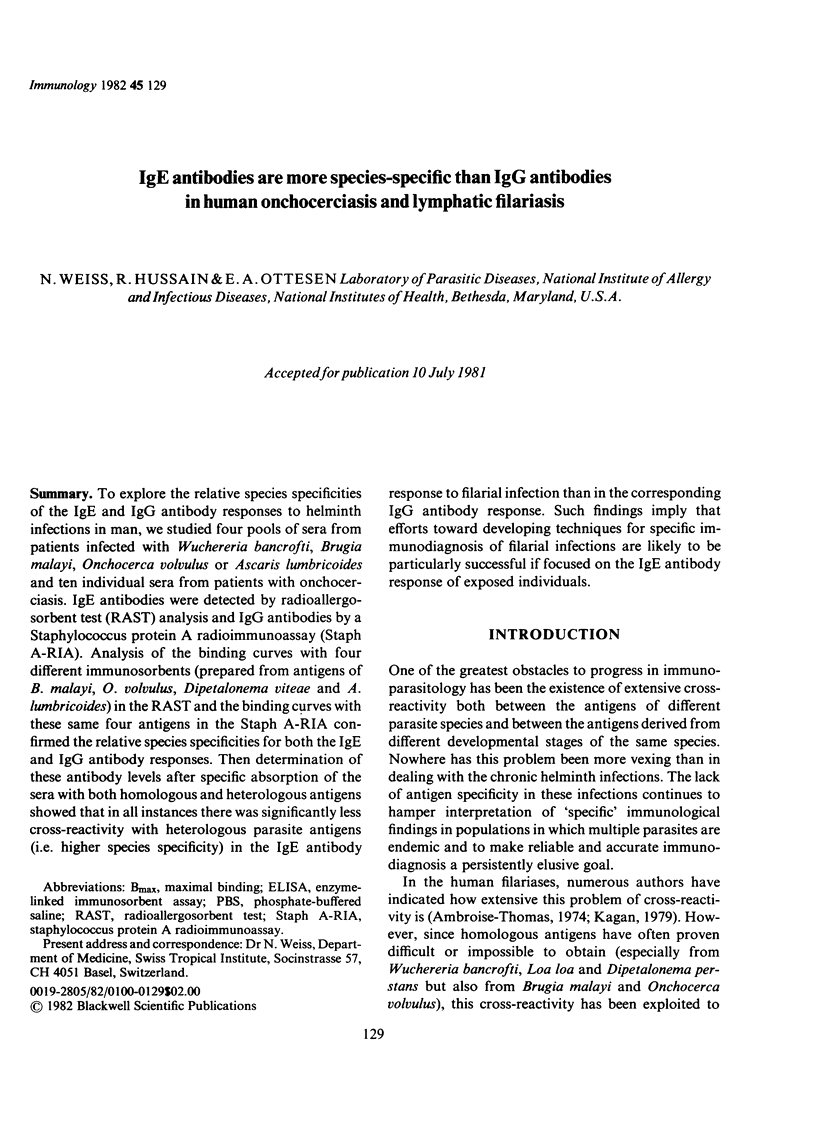

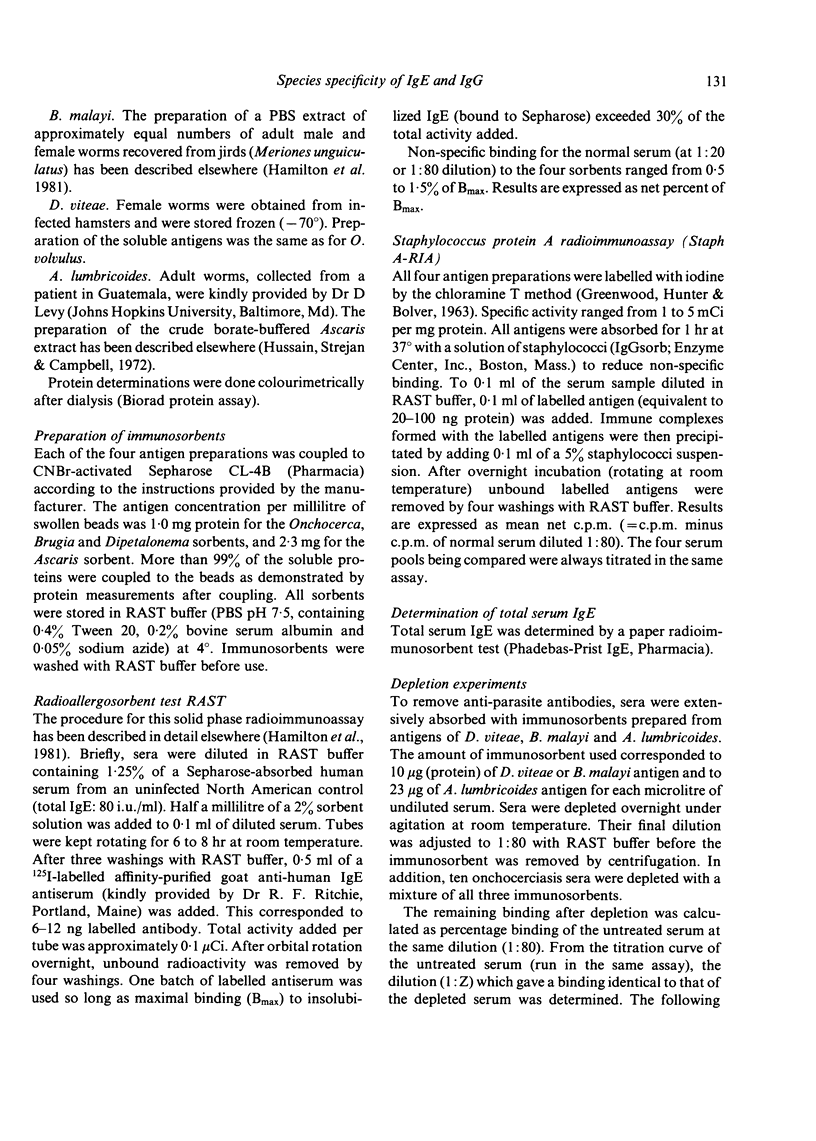
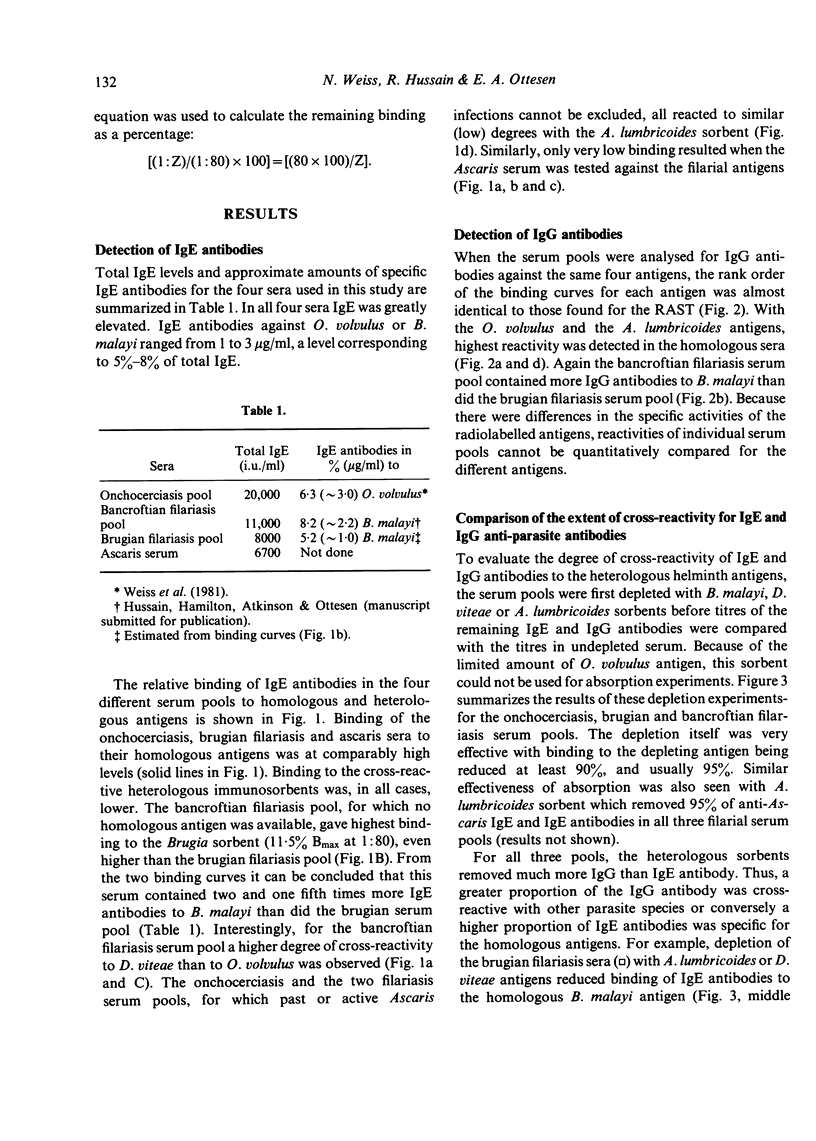

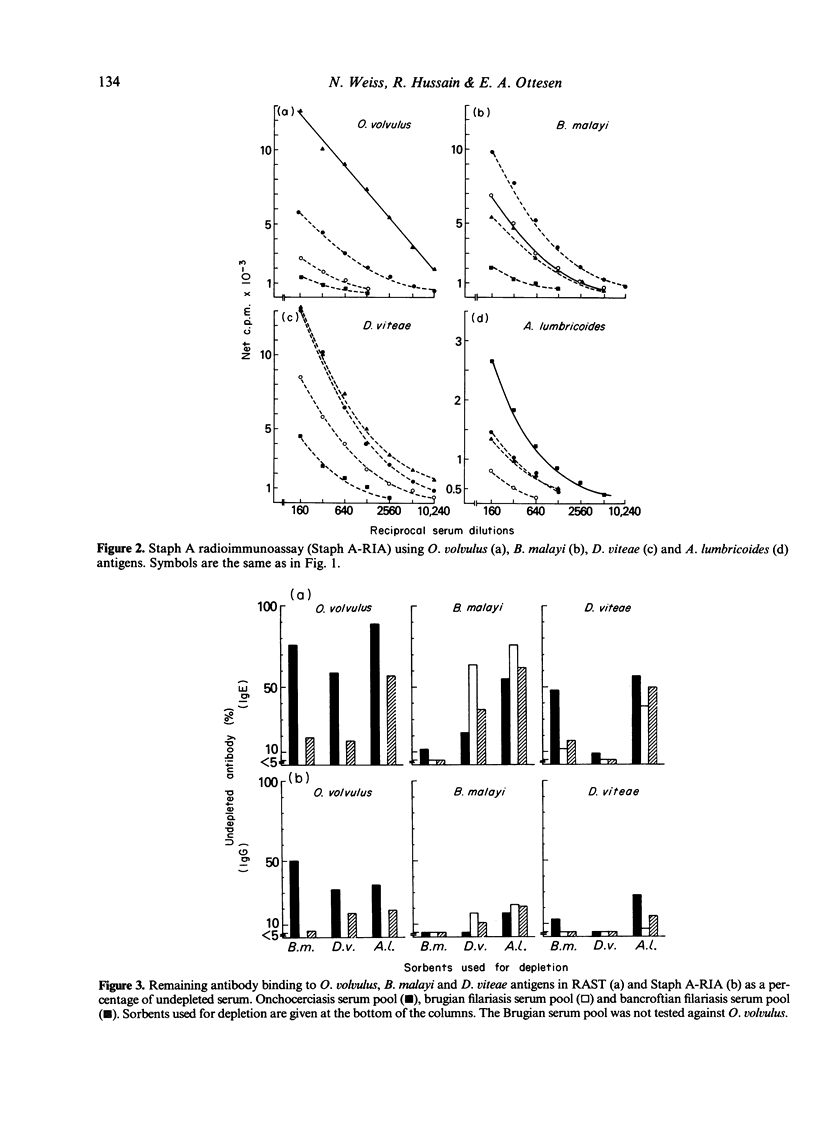
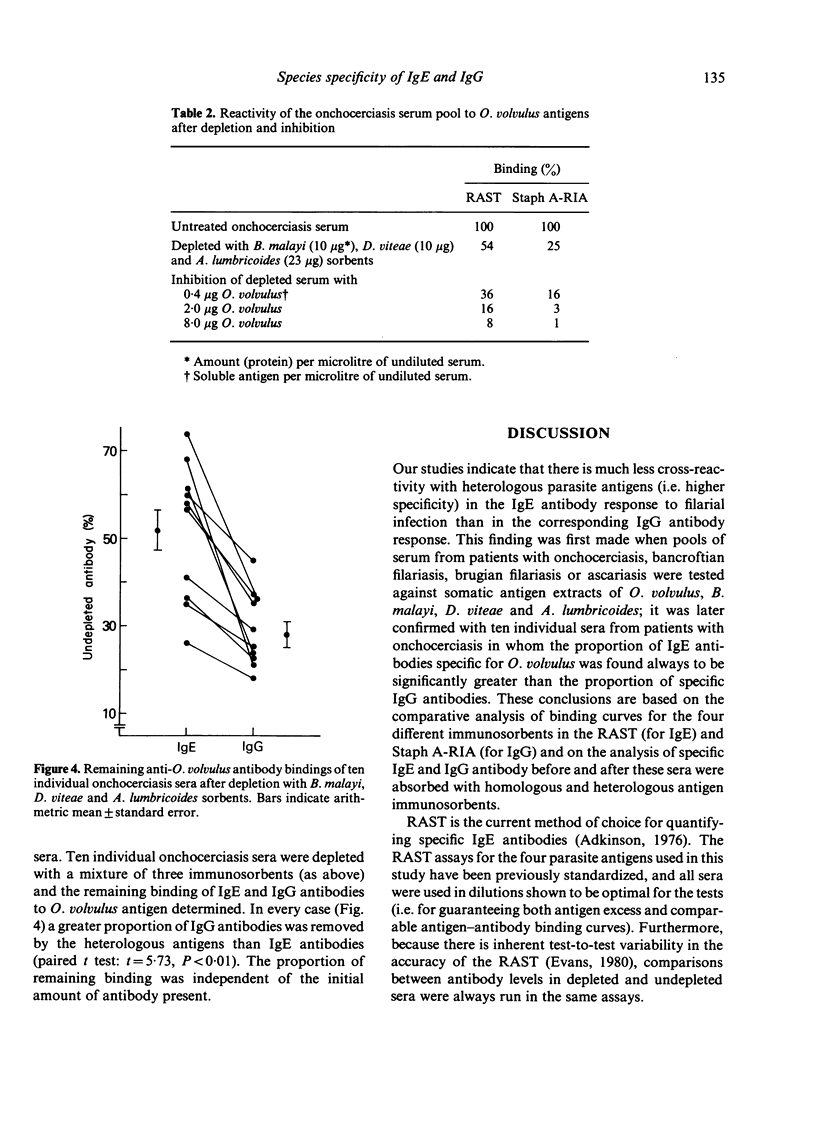
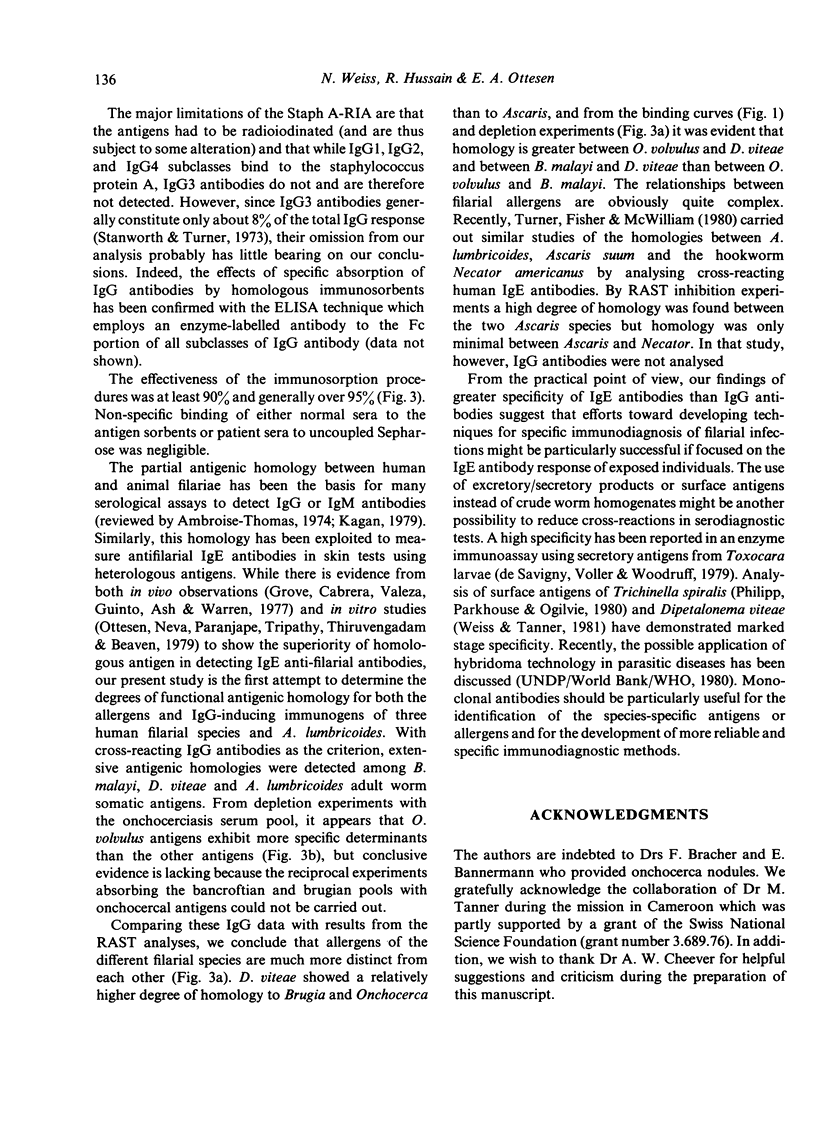
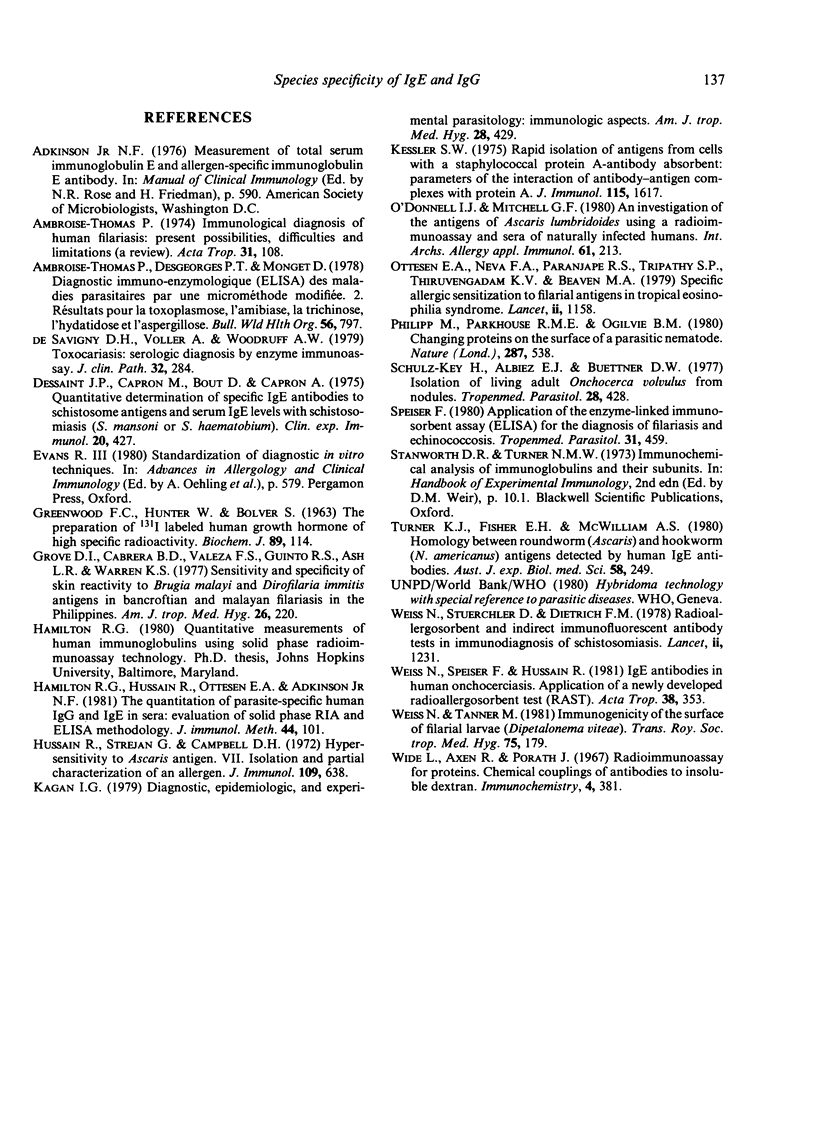
Selected References
These references are in PubMed. This may not be the complete list of references from this article.
- Ambroise-Thomas P., Desgeorges P. T., Monget D. Diagnostic immuno-enzymologique (ELISA) des maladies parasitaires par une microméthode modifiée. 2. Résultats pour la toxoplasmose, l'amibiase, la trichinose, l'hydatidose et l'aspergillose. Bull World Health Organ. 1978;56(5):797–804. [PMC free article] [PubMed] [Google Scholar]
- Ambroise-Thomas P. Immunological diagnosis of human filariases: present possibilities, difficulties and limitations. Acta Trop. 1974;31(2):108–128. [PubMed] [Google Scholar]
- GREENWOOD F. C., HUNTER W. M., GLOVER J. S. THE PREPARATION OF I-131-LABELLED HUMAN GROWTH HORMONE OF HIGH SPECIFIC RADIOACTIVITY. Biochem J. 1963 Oct;89:114–123. doi: 10.1042/bj0890114. [DOI] [PMC free article] [PubMed] [Google Scholar]
- Grove D. I., Cabrera B. D., Valeza F. S., Guinto R. S., Ash L. R., Warren K. S. Sensitivity and specificity of skin reactivity to Brugia malayi and Dirofilaria immitis antigens in Bancroftian and Malayan filariasis in the Philippines. Am J Trop Med Hyg. 1977 Mar;26(2):220–229. doi: 10.4269/ajtmh.1977.26.220. [DOI] [PubMed] [Google Scholar]
- Hamilton R. G., Hussain R., Ottesen E. A., Adkinson N. F., Jr The quantitation of parasite-specific human IgG and IgE in sera: evaluation of solid-phase RIA and ELISA methodology. J Immunol Methods. 1981;44(1):101–114. doi: 10.1016/0022-1759(81)90111-3. [DOI] [PubMed] [Google Scholar]
- Hussain R., Strejan G., Campbell D. H. Hypersensitivity to ascaris antigens. VII. Isolation and partial characterization of an allergen. J Immunol. 1972 Sep;109(3):638–647. [PubMed] [Google Scholar]
- Kagan I. G. Diagnostic, epidemiologic, and experimental parasitology: immunologic aspects. Am J Trop Med Hyg. 1979 May;28(3):429–439. doi: 10.4269/ajtmh.1979.28.429. [DOI] [PubMed] [Google Scholar]
- Kessler S. W. Rapid isolation of antigens from cells with a staphylococcal protein A-antibody adsorbent: parameters of the interaction of antibody-antigen complexes with protein A. J Immunol. 1975 Dec;115(6):1617–1624. [PubMed] [Google Scholar]
- O'Donnell I. J., Mitchell G. F. An investigation of the antigens of Ascaris lumbricoides using a radioimmunoassay and sera of naturally infected humans. Int Arch Allergy Appl Immunol. 1980;61(2):213–219. doi: 10.1159/000232435. [DOI] [PubMed] [Google Scholar]
- Ottesen E. A., Neva F. A., Paranjape R. S., Tripathy S. P., Thiruvengadam K. V., Beaven M. A. Specific allergic sensitsation to filarial antigens in tropical eosinophilia syndrome. Lancet. 1979 Jun 2;1(8127):1158–1161. doi: 10.1016/s0140-6736(79)91842-7. [DOI] [PubMed] [Google Scholar]
- Philipp M., Parkhouse R. M., Ogilvie B. M. Changing proteins on the surface of a parasitic nematode. Nature. 1980 Oct 9;287(5782):538–540. doi: 10.1038/287538a0. [DOI] [PubMed] [Google Scholar]
- Schulz-Key H., Albiez E. J., Büttner D. W. Isolation of living adult Onchocerca volvulus from nodules. Tropenmed Parasitol. 1977 Dec;28(4):428–430. [PubMed] [Google Scholar]
- Speiser F. Application of the enzyme-linked immunosorbent assay (ELISA) for the diagnosis of filariasis and echinococcosis. Tropenmed Parasitol. 1980 Dec;31(4):459–466. [PubMed] [Google Scholar]
- Turner K. J., Fisher E. H., McWilliam A. S. Homology between roundworm (Ascaris) and hookworm (N. americanus) antigens detected by human IgE antibodies. Aust J Exp Biol Med Sci. 1980 Jun;58(3):249–257. doi: 10.1038/icb.1980.25. [DOI] [PubMed] [Google Scholar]
- Weiss N., Speiser F., Hussain R. IgE antibodies in human onchocerciasis. Application of a newly developed radioallergosorbent test (RAST). Acta Trop. 1981 Sep;38(3):353–362. [PubMed] [Google Scholar]
- Weiss N., Stürchler D., Dietrich F. M. Radioallergosorbent and indirect fluorescent antibody tests in immunodiagnosis of schistosomiasis. Lancet. 1978 Dec 9;2(8102):1231–1233. doi: 10.1016/s0140-6736(78)92102-5. [DOI] [PubMed] [Google Scholar]
- Weiss N., Tanner M. Immunogenicity of the surface of filarial larvae (Dipetalonema viteae). Trans R Soc Trop Med Hyg. 1981;75(1):179–181. doi: 10.1016/0035-9203(81)90062-6. [DOI] [PubMed] [Google Scholar]
- de Savigny D. H., Voller A., Woodruff A. W. Toxocariasis: serological diagnosis by enzyme immunoassay. J Clin Pathol. 1979 Mar;32(3):284–288. doi: 10.1136/jcp.32.3.284. [DOI] [PMC free article] [PubMed] [Google Scholar]


